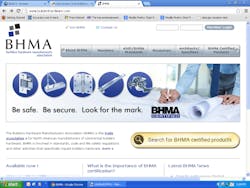When you leave your office, the gym, a school or a hotel, chances are you don’t give any thought to walking through those doors and stepping outside. But an entire range of builders hardware exists to control those exit doors by holding them open, keeping them closed, and automatically closing them behind you to conserve energy or keep a property secure.
Even more importantly, exit devices play a key role in emergencies by allowing large groups of people to leave a building quickly and by automatically and safely shutting fire doors behind them to contain fires.
The Builders Hardware Manufacturers Association (BHMA) has been certifying builders hardware since 1969 and a great deal of its standards cover exit devices and means of egress, due to its enormous importance in maintaining safe, secure, and convenient spaces.
With natural disasters, fires, and school safety dominating headlines lately, people are paying closer attention to how we get out when we absolutely have to – and how we keep buildings secure when we don’t.
Builders Hardware for Exits and What It Does
While thousands of specific builders hardware products control means of egress, general categories defined and specified by BHMA include exit devices, door control-closers, stops and holders, and release devices.
Exit devices. Made for buildings which contain large amounts of people, exit devices are required by code in buildings with at least 50 occupants. They are also referred to as “panic” exit devices and some can be found on fire exits. Styles vary, but all include an “actuating bar” which extends at least half the width of the door. Examples include crossbars on school doors, automatic and self-latching flush bolts, and removable mullions.
Exit devices are always for egress, not for entering, so additional hardware may be required to allow access from outside. Most of these exit doors contain or have the option to include entry trim with available functions such as keyed locking and latch retraction by lever.
Door control-closers. Door control-closers are usually mechanical, worked by hydraulics and springs. They keep the door from flying open, control its swing, and hold a door open when necessary. A large spring down the middle with hydraulic oil inside is used to slow down the closing process and prevent doors from quickly slamming shut.
These products work by utilizing the energy used to open in order to close it again. Different door sizes require various corresponding powers and are adjustable so builders can increase or decrease speed.
While bigger doors may need stronger closers, that’s not the only factor when choosing the type of control-closer. The location of a door must be considered. For example, high rise buildings contain excess air, which will naturally seek to move downward and out. This is referred to as “stack pressure”. When this is a factor, even a regularly sized door may need a stronger closer.
Stops and holders. The general term for overhead stops and holders is “door controls.” These are all of the products that control the opening and closing of a door. Surface-mounted and concealed at the top of the door, door controls are found on larger doors in schools, churches, and some office buildings. Unlike release devices, these are not electrical or tied into an alarm system.
Surface-mounted and concealed, door controls usually involve putting something large, such as an arm, above the door in order to prop it open. They are also used to close doors in emergency situations, after use to conserve energy, or for security, to make sure potential entrances to a property are inaccessible.
Release devices. Release devices hold doors in an open position. They include closer holders, electromagnetic, and electromechanical releases. Usually housed on a wall, release devices are commonly found on fire doors.
While fire doors always have to be closed and securely latched during a fire for containment, these doors are commonly kept in an open position during non-emergencies. Release devices operate in conjunction with a door closer. The devices are electronic and tied into a building’s alarm system so that in an emergency, fire doors can be automatically closed once the fire alarm is triggered. This allows for containment of a fire, limits damage, and saves lives.
How Builders Hardware for Exits is Tested
BHMA requires specific testing for hardware used for means of egress. Its function during emergencies requires special consideration. In many cases, hardware must meet additional standards and codes before it can be tested to BHMA standards.
Since it is critical to safety, hardware on fire exit devices is fire rated, meaning that it must meet standards for fire safety as well as BHMA standards. Exit devices must meet the Underwriters Laboratories UL 305 rating for panic hardware in addition to BHMA’s rating. Testing for these devices is more rigorous, with products forced to undergo 500,000 or more cycles depending upon the grade level.
For door control-closers, doors must first be prepared for testing by weighing the door, mounted properly on hinges. Then specific machinery is employed to open the door to 90 degrees no less than 2 million times – a process which can take several months.
Per BHMA regulations, there are six sizes of closers. These are defined by closing force, which is measured at a certain point in the swing. When you push a door open, you exert a specific amount of force on the door. Builders want to ensure that the door closes with a similar amount of force, though inevitably it will close with less force than the amount used to open it. Builders try to keep this closing force to about 60 percent. So if a door is pushed open with 10 pounds of force, it would ideally return with six pounds.
Testing for door controls (stops and holders) is described for five different types:
- Single point adjustable hold-open
- Single point non-adjustable hold-open
- Positive type holders less automatic release feature
- Friction slide type holders
- Non-friction slide or stop-only types
Stops and holders are tested in the stop position to ensure they can withstand a force of up to 300 pounds of unauthorized closing without sustaining damage. As with most BHMA products, door controls are also tested for durability and appearance.
Exit devices play a key role in the smooth operation of public spaces. When everything operates smoothly, they continue to go unnoticed – and that means the Builders Hardware Manufacturers Association is doing its job. ANSI/BHMA standards ensure everything performs perfectly, which is comforting to know when you need those exits the most.
BHMA is the only organization accredited by the American National Standards Institute (ANSI) to develop and maintain performance standards for locks, closers, exit devices and other builders hardware. The widely known ANSI/BHMA A156 series of standards describes and establishes the features and criteria for specific types of hardware products. In addition, BHMA sponsors third-party certification of hardware products, which is a requirement for a product to bear the “BHMA Certified” mark — ensuring that the product meets the ANSI/BHMA standard. For more information, visit the Web site www.buildershardware.com.






